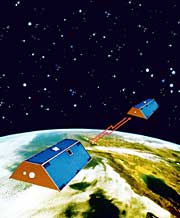Science / Two satellites will monitor tiny changes in the mass of continents and oceans
Yuval Dror

Photo: NASA "Grace" satellites. will orbit the Earth for five years
300 years after the apple fell on Isaac Newton's head, a fall that, according to legend, helped him formulate the laws of gravity, the American space agency, NASA, is about to launch into space two satellites that will precisely measure the different areas of gravity on Earth and help scientists understand how Earth has recovered from the ice age. Today, for example, it is known that the gravity in India is about XNUMX percent lower than in other regions on Earth, thanks to the changes that have occurred in the region's gravity since the Ice Age.
The Earth, NASA researchers explain, is not smooth but full of lumps - which we call simply "mountains". These mountains, as well as the large oceans, cause changes in the force of gravity in different regions of the Earth - the greater the mass of a mountain or ocean, the stronger the force of gravity.
Dr. Michael Watkins, who heads the new project, explains that there are two main types of gravitational forces on Earth. "The first force of gravity hardly changes over the years, and the changes that do apply to it usually occur because the oceans have more water due to the warming of the poles and the turning of ice into water."
The second force of gravity, according to Watkins, is the one that changes more often, in terms of the evolution of a planet. "The area of the north and south poles was larger in the past. The fact that the poles melt slowly reduces the pressure exerted by the ice layer on the ground, and therefore the ground rises. This is the reason that northern Canada and Scandinavia are rising in the last few hundred years - as the Earth - whose shape tends to be elliptical - is becoming spherical again and this is manifested in changes in its gravity zones", he said in an interview published on the NASA website.
The traditional way to measure the gravity in a certain area is shockingly simple: drop something and check the trajectory of its fall. This "something" is called a "gravity meter". While this solution is simple, it has a glaring drawback: you have to drop it at every point in the world to get a complete snapshot. This is where NASA comes into the picture.
In the coming weeks, NASA will launch into space two satellites called Climatic Grace (Experiment Gravity Recovery and), which will help build a more accurate map of the changes that occur in gravity. The satellites will move around the Earth for five years, at a constant speed and at a distance of 220 kilometers from each other. A radio beam that will be sent between the two devices will allow the team of researchers to measure the distance between them with an accuracy of one fifth of the thickness of a human hair, or one micron.
"Imagine that the satellites are approaching a large mountain. The first satellite will feel the mass of the mountain before the second satellite will feel it, and therefore the first satellite will be attracted to it (due to gravity) at a higher speed than the second satellite, and thus the distance between the two satellites will change," explained Watkins. "We will be able to measure these tiny changes and thus be able to map the entire planet."
According to Watkins, the map that will be built based on the measurements of the "Grace" satellites, will be 100 times more accurate than the maps that exist today, which are mainly based on mathematical models. According to Watkins, the satellites will map the Earth once a month and since the mission will last at least five years, the researchers will be able to check for tiny changes between the different maps. "We will be able to see tiny changes in the masses of continents and oceans, changes in which are almost impossible to distinguish through other measurements."
